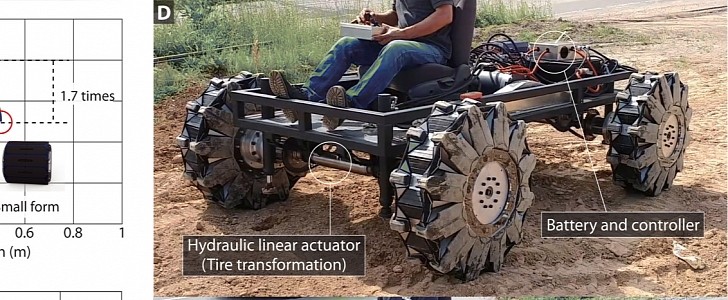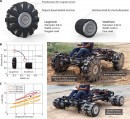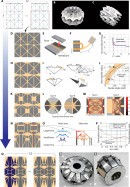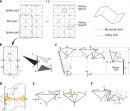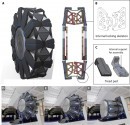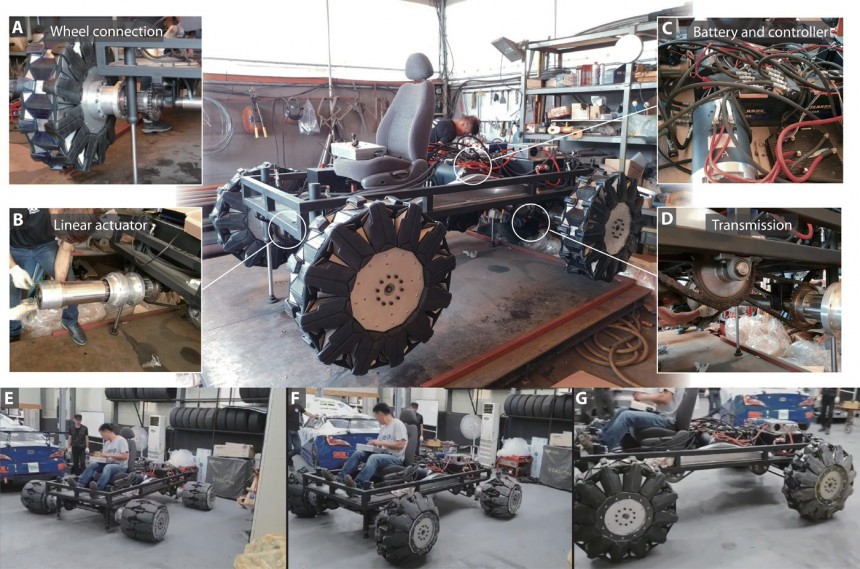You can’t reinvent the wheel, it is often said. To which researchers from Seoul National University, Harvard University, and Hankook Tire and Technology Co. go, “hold my beer.”
This is oversimplifying it, but it is accurate: researchers have developed a new wheel prototype, one that is able to change shape and tread at the push of a button, making it ideal for use on all types of terrain with zero preparation in advance. It is called the “high-load capacity origami transformable wheel,” according to this paper published in Science Robotic (hat top to Interesting Engineering).
This origami wheel has been in development for a very long time, and the latest prototype comes with countless improvements over earlier models. So much so that researchers are happy with sharing it with the world, via the paper and the video available at the bottom of the page. Of note is the fact that the wheel can now transform in motion and that it can now carry as much as 2,248 pounds (1,019 kg) of weight on top of the platform.
Based on a waterbomb tesselation origami pattern, the wheel changes shape under pressure, with a range in diameter from 18 to 31 inches (46 to 80 cm), achievable at the press of a button. Simply put, when you apply pressure from the side, the wheel goes from short and fat to skinny and tall, but with a more pronounced tread. The former shape is perfect for slippery terrain like sand, while the latter is ideal for climbing over obstacles, providing maximum grip. Researchers also point out that the lower structure is good for driving under obstacles.
Previous prototypes could not support any weight during the transition process, but researchers have been able to make that happen, even putting a full-size vehicle on top. The origami design of the wheel comprises three layers of thick, flexible membranes that fold outward, which makes them soft and able to absorb distortions from the rough terrain. The non-folding panels are sandwiched with laser-cut aluminum panels for maximum durability, while internal locking plates keep the wheel from flattening out once it’s shape-shifted.
Each wheel is capable of withstanding a load of 10 ± 2 kilonewtons, while the transformation from one shape to the other takes five seconds, at the speed of one meter (3.2 feet) per second. As you can see in the video, researchers are still working on getting all four wheels to synchronize when they’re transforming, but the real achievement here is that they’ve been able to put a vehicle and a human operator on top.
Researchers note that there’s a suspension benefit, too. Because it’s made of several layers and a multitude of panels, the wheel is springy.
The idea for this wheel prototype is that it would be just perfect for a vehicle meant for all variety of terrains when access to said terrains is impossible. In other words, researchers say the best possible applications are for rovers meant for the exploration of alien planets and combat robots. In both these cases, it would be difficult to fit a vehicle with the wheel best suited for the unpredictable or unknown environment it would have to cross.
Commercial application is far off, if even possible. As you can see in the video, when the wheel is in the higher shape, the ride is incredibly bumpy, to say the least. Researchers say commercial appeal could increase if they covered the outer plates with traditional rubber, but they still concede that industrial / military use would be a much better fit for such a product.
This origami wheel has been in development for a very long time, and the latest prototype comes with countless improvements over earlier models. So much so that researchers are happy with sharing it with the world, via the paper and the video available at the bottom of the page. Of note is the fact that the wheel can now transform in motion and that it can now carry as much as 2,248 pounds (1,019 kg) of weight on top of the platform.
Previous prototypes could not support any weight during the transition process, but researchers have been able to make that happen, even putting a full-size vehicle on top. The origami design of the wheel comprises three layers of thick, flexible membranes that fold outward, which makes them soft and able to absorb distortions from the rough terrain. The non-folding panels are sandwiched with laser-cut aluminum panels for maximum durability, while internal locking plates keep the wheel from flattening out once it’s shape-shifted.
Each wheel is capable of withstanding a load of 10 ± 2 kilonewtons, while the transformation from one shape to the other takes five seconds, at the speed of one meter (3.2 feet) per second. As you can see in the video, researchers are still working on getting all four wheels to synchronize when they’re transforming, but the real achievement here is that they’ve been able to put a vehicle and a human operator on top.
The idea for this wheel prototype is that it would be just perfect for a vehicle meant for all variety of terrains when access to said terrains is impossible. In other words, researchers say the best possible applications are for rovers meant for the exploration of alien planets and combat robots. In both these cases, it would be difficult to fit a vehicle with the wheel best suited for the unpredictable or unknown environment it would have to cross.
Commercial application is far off, if even possible. As you can see in the video, when the wheel is in the higher shape, the ride is incredibly bumpy, to say the least. Researchers say commercial appeal could increase if they covered the outer plates with traditional rubber, but they still concede that industrial / military use would be a much better fit for such a product.
